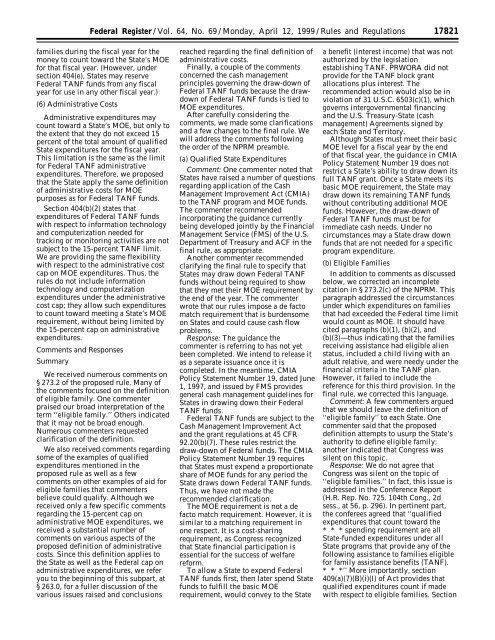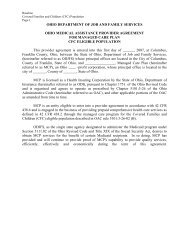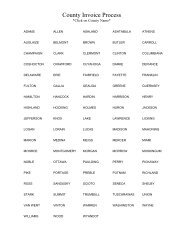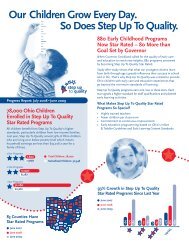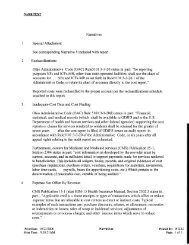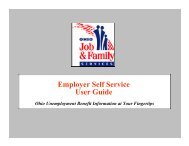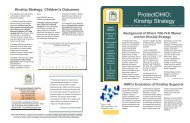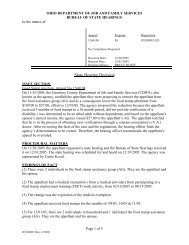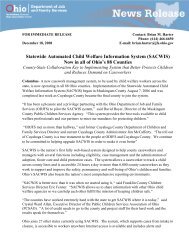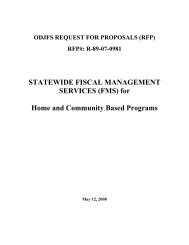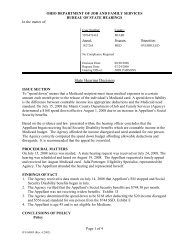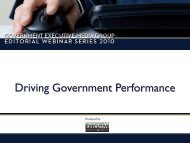Final TANF Rule as published in the Federal Register 4/12/1999
Final TANF Rule as published in the Federal Register 4/12/1999
Final TANF Rule as published in the Federal Register 4/12/1999
You also want an ePaper? Increase the reach of your titles
YUMPU automatically turns print PDFs into web optimized ePapers that Google loves.
<strong>Federal</strong> <strong>Register</strong> / Vol. 64, No. 69 / Monday, April <strong>12</strong>, <strong>1999</strong> / <strong>Rule</strong>s and Regulations<br />
families dur<strong>in</strong>g <strong>the</strong> fiscal year for <strong>the</strong><br />
money to count toward <strong>the</strong> State’s MOE<br />
for that fiscal year. (However, under<br />
section 404(e), States may reserve<br />
<strong>Federal</strong> <strong>TANF</strong> funds from any fiscal<br />
year for use <strong>in</strong> any o<strong>the</strong>r fiscal year.)<br />
(6) Adm<strong>in</strong>istrative Costs<br />
Adm<strong>in</strong>istrative expenditures may<br />
count toward a State’s MOE, but only to<br />
<strong>the</strong> extent that <strong>the</strong>y do not exceed 15<br />
percent of <strong>the</strong> total amount of qualified<br />
State expenditures for <strong>the</strong> fiscal year.<br />
This limitation is <strong>the</strong> same <strong>as</strong> <strong>the</strong> limit<br />
for <strong>Federal</strong> <strong>TANF</strong> adm<strong>in</strong>istrative<br />
expenditures. Therefore, we proposed<br />
that <strong>the</strong> State apply <strong>the</strong> same def<strong>in</strong>ition<br />
of adm<strong>in</strong>istrative costs for MOE<br />
purposes <strong>as</strong> for <strong>Federal</strong> <strong>TANF</strong> funds.<br />
Section 404(b)(2) states that<br />
expenditures of <strong>Federal</strong> <strong>TANF</strong> funds<br />
with respect to <strong>in</strong>formation technology<br />
and computerization needed for<br />
track<strong>in</strong>g or monitor<strong>in</strong>g activities are not<br />
subject to <strong>the</strong> 15-percent <strong>TANF</strong> limit.<br />
We are provid<strong>in</strong>g <strong>the</strong> same flexibility<br />
with respect to <strong>the</strong> adm<strong>in</strong>istrative cost<br />
cap on MOE expenditures. Thus, <strong>the</strong><br />
rules do not <strong>in</strong>clude <strong>in</strong>formation<br />
technology and computerization<br />
expenditures under <strong>the</strong> adm<strong>in</strong>istrative<br />
cost cap; <strong>the</strong>y allow such expenditures<br />
to count toward meet<strong>in</strong>g a State’s MOE<br />
requirement, without be<strong>in</strong>g limited by<br />
<strong>the</strong> 15-percent cap on adm<strong>in</strong>istrative<br />
expenditures.<br />
Comments and Responses<br />
Summary<br />
We received numerous comments on<br />
§ 273.2 of <strong>the</strong> proposed rule. Many of<br />
<strong>the</strong> comments focused on <strong>the</strong> def<strong>in</strong>ition<br />
of eligible family. One commenter<br />
praised our broad <strong>in</strong>terpretation of <strong>the</strong><br />
term ‘‘eligible family.’’ O<strong>the</strong>rs <strong>in</strong>dicated<br />
that it may not be broad enough.<br />
Numerous commenters requested<br />
clarification of <strong>the</strong> def<strong>in</strong>ition.<br />
We also received comments regard<strong>in</strong>g<br />
some of <strong>the</strong> examples of qualified<br />
expenditures mentioned <strong>in</strong> <strong>the</strong><br />
proposed rule <strong>as</strong> well <strong>as</strong> a few<br />
comments on o<strong>the</strong>r examples of aid for<br />
eligible families that commenters<br />
believe could qualify. Although we<br />
received only a few specific comments<br />
regard<strong>in</strong>g <strong>the</strong> 15-percent cap on<br />
adm<strong>in</strong>istrative MOE expenditures, we<br />
received a substantial number of<br />
comments on various <strong>as</strong>pects of <strong>the</strong><br />
proposed def<strong>in</strong>ition of adm<strong>in</strong>istrative<br />
costs. S<strong>in</strong>ce this def<strong>in</strong>ition applies to<br />
<strong>the</strong> State <strong>as</strong> well <strong>as</strong> <strong>the</strong> <strong>Federal</strong> cap on<br />
adm<strong>in</strong>istrative expenditures, we refer<br />
you to <strong>the</strong> beg<strong>in</strong>n<strong>in</strong>g of this subpart, at<br />
§ 263.0, for a fuller discussion of <strong>the</strong><br />
various issues raised and conclusions<br />
reached regard<strong>in</strong>g <strong>the</strong> f<strong>in</strong>al def<strong>in</strong>ition of<br />
adm<strong>in</strong>istrative costs.<br />
<strong>F<strong>in</strong>al</strong>ly, a couple of <strong>the</strong> comments<br />
concerned <strong>the</strong> c<strong>as</strong>h management<br />
pr<strong>in</strong>ciples govern<strong>in</strong>g <strong>the</strong> draw-down of<br />
<strong>Federal</strong> <strong>TANF</strong> funds because <strong>the</strong> drawdown<br />
of <strong>Federal</strong> <strong>TANF</strong> funds is tied to<br />
MOE expenditures.<br />
After carefully consider<strong>in</strong>g <strong>the</strong><br />
comments, we made some clarifications<br />
and a few changes to <strong>the</strong> f<strong>in</strong>al rule. We<br />
will address <strong>the</strong> comments follow<strong>in</strong>g<br />
<strong>the</strong> order of <strong>the</strong> NPRM preamble.<br />
(a) Qualified State Expenditures<br />
Comment: One commenter noted that<br />
States have raised a number of questions<br />
regard<strong>in</strong>g application of <strong>the</strong> C<strong>as</strong>h<br />
Management Improvement Act (CMIA)<br />
to <strong>the</strong> <strong>TANF</strong> program and MOE funds.<br />
The commenter recommended<br />
<strong>in</strong>corporat<strong>in</strong>g <strong>the</strong> guidance currently<br />
be<strong>in</strong>g developed jo<strong>in</strong>tly by <strong>the</strong> F<strong>in</strong>ancial<br />
Management Service (FMS) of <strong>the</strong> U.S.<br />
Department of Tre<strong>as</strong>ury and ACF <strong>in</strong> <strong>the</strong><br />
f<strong>in</strong>al rule, <strong>as</strong> appropriate.<br />
Ano<strong>the</strong>r commenter recommended<br />
clarify<strong>in</strong>g <strong>the</strong> f<strong>in</strong>al rule to specify that<br />
States may draw down <strong>Federal</strong> <strong>TANF</strong><br />
funds without be<strong>in</strong>g required to show<br />
that <strong>the</strong>y met <strong>the</strong>ir MOE requirement by<br />
<strong>the</strong> end of <strong>the</strong> year. The commenter<br />
wrote that our rules impose a de facto<br />
match requirement that is burdensome<br />
on States and could cause c<strong>as</strong>h flow<br />
problems.<br />
Response: The guidance <strong>the</strong><br />
commenter is referr<strong>in</strong>g to h<strong>as</strong> not yet<br />
been completed. We <strong>in</strong>tend to rele<strong>as</strong>e it<br />
<strong>as</strong> a separate issuance once it is<br />
completed. In <strong>the</strong> meantime, CMIA<br />
Policy Statement Number 19, dated June<br />
1, 1997, and issued by FMS provides<br />
general c<strong>as</strong>h management guidel<strong>in</strong>es for<br />
States <strong>in</strong> draw<strong>in</strong>g down <strong>the</strong>ir <strong>Federal</strong><br />
<strong>TANF</strong> funds.<br />
<strong>Federal</strong> <strong>TANF</strong> funds are subject to <strong>the</strong><br />
C<strong>as</strong>h Management Improvement Act<br />
and <strong>the</strong> grant regulations at 45 CFR<br />
92.20(b)(7). These rules restrict <strong>the</strong><br />
draw-down of <strong>Federal</strong> funds. The CMIA<br />
Policy Statement Number 19 requires<br />
that States must expend a proportionate<br />
share of MOE funds for any period <strong>the</strong><br />
State draws down <strong>Federal</strong> <strong>TANF</strong> funds.<br />
Thus, we have not made <strong>the</strong><br />
recommended clarification.<br />
The MOE requirement is not a de<br />
facto match requirement. However, it is<br />
similar to a match<strong>in</strong>g requirement <strong>in</strong><br />
one respect. It is a cost-shar<strong>in</strong>g<br />
requirement, <strong>as</strong> Congress recognized<br />
that State f<strong>in</strong>ancial participation is<br />
essential for <strong>the</strong> success of welfare<br />
reform.<br />
To allow a State to expend <strong>Federal</strong><br />
<strong>TANF</strong> funds first, <strong>the</strong>n later spend State<br />
funds to fulfill <strong>the</strong> b<strong>as</strong>ic MOE<br />
requirement, would convey to <strong>the</strong> State<br />
17821<br />
a benefit (<strong>in</strong>terest <strong>in</strong>come) that w<strong>as</strong> not<br />
authorized by <strong>the</strong> legislation<br />
establish<strong>in</strong>g <strong>TANF</strong>. PRWORA did not<br />
provide for <strong>the</strong> <strong>TANF</strong> block grant<br />
allocations plus <strong>in</strong>terest. The<br />
recommended action would also be <strong>in</strong><br />
violation of 31 U.S.C. 6503(c)(1), which<br />
governs <strong>in</strong>tergovernmental f<strong>in</strong>anc<strong>in</strong>g<br />
and <strong>the</strong> U.S. Tre<strong>as</strong>ury-State (c<strong>as</strong>h<br />
management) Agreements signed by<br />
each State and Territory.<br />
Although States must meet <strong>the</strong>ir b<strong>as</strong>ic<br />
MOE level for a fiscal year by <strong>the</strong> end<br />
of that fiscal year, <strong>the</strong> guidance <strong>in</strong> CMIA<br />
Policy Statement Number 19 does not<br />
restrict a State’s ability to draw down its<br />
full <strong>TANF</strong> grant. Once a State meets its<br />
b<strong>as</strong>ic MOE requirement, <strong>the</strong> State may<br />
draw down its rema<strong>in</strong><strong>in</strong>g <strong>TANF</strong> funds<br />
without contribut<strong>in</strong>g additional MOE<br />
funds. However, <strong>the</strong> draw-down of<br />
<strong>Federal</strong> <strong>TANF</strong> funds must be for<br />
immediate c<strong>as</strong>h needs. Under no<br />
circumstances may a State draw down<br />
funds that are not needed for a specific<br />
program expenditure.<br />
(b) Eligible Families<br />
In addition to comments <strong>as</strong> discussed<br />
below, we corrected an <strong>in</strong>complete<br />
citation <strong>in</strong> § 273.2(c) of <strong>the</strong> NPRM. This<br />
paragraph addressed <strong>the</strong> circumstances<br />
under which expenditures on families<br />
that had exceeded <strong>the</strong> <strong>Federal</strong> time limit<br />
would count <strong>as</strong> MOE. It should have<br />
cited paragraphs (b)(1), (b)(2), and<br />
(b)(3)—thus <strong>in</strong>dicat<strong>in</strong>g that <strong>the</strong> families<br />
receiv<strong>in</strong>g <strong>as</strong>sistance had eligible alien<br />
status, <strong>in</strong>cluded a child liv<strong>in</strong>g with an<br />
adult relative, and were needy under <strong>the</strong><br />
f<strong>in</strong>ancial criteria <strong>in</strong> <strong>the</strong> <strong>TANF</strong> plan.<br />
However, it failed to <strong>in</strong>clude <strong>the</strong><br />
reference for this third provision. In <strong>the</strong><br />
f<strong>in</strong>al rule, we corrected this language.<br />
Comment: A few commenters argued<br />
that we should leave <strong>the</strong> def<strong>in</strong>ition of<br />
‘‘eligible family’’ to each State. One<br />
commenter said that <strong>the</strong> proposed<br />
def<strong>in</strong>ition attempts to usurp <strong>the</strong> State’s<br />
authority to def<strong>in</strong>e eligible family;<br />
ano<strong>the</strong>r <strong>in</strong>dicated that Congress w<strong>as</strong><br />
silent on this topic.<br />
Response: We do not agree that<br />
Congress w<strong>as</strong> silent on <strong>the</strong> topic of<br />
‘‘eligible families.’’ In fact, this issue is<br />
addressed <strong>in</strong> <strong>the</strong> Conference Report<br />
(H.R. Rep. No. 725. 104th Cong., 2d<br />
sess., at 56, p. 296). In pert<strong>in</strong>ent part,<br />
<strong>the</strong> conferees agreed that ‘‘qualified<br />
expenditures that count toward <strong>the</strong><br />
* * * spend<strong>in</strong>g requirement are all<br />
State-funded expenditures under all<br />
State programs that provide any of <strong>the</strong><br />
follow<strong>in</strong>g <strong>as</strong>sistance to families eligible<br />
for family <strong>as</strong>sistance benefits (<strong>TANF</strong>).<br />
* * *’’ More importantly, section<br />
409(a)(7)(B)(i)(I) of Act provides that<br />
qualified expenditures count if made<br />
with respect to eligible families. Section


